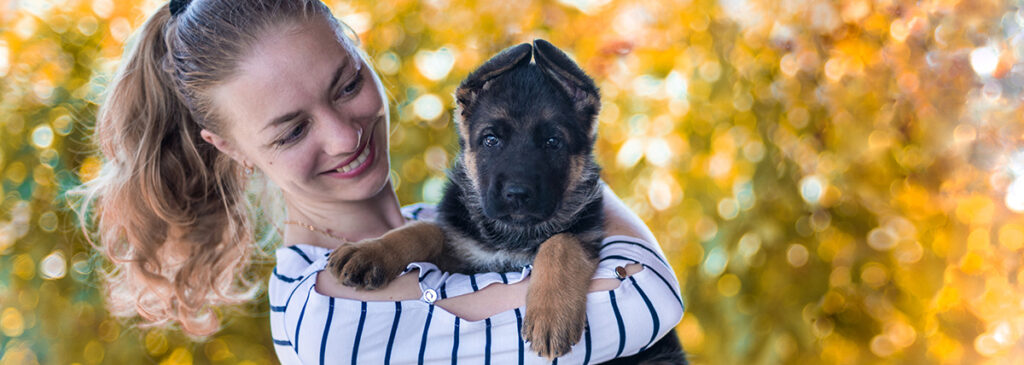
Selecting your German Shepherd Puppy
By visiting GSDLiving and this page, you are taking the first—and most important—step toward finding the perfect German Shepherd puppy. By increasing your knowledge of the breed and setting expectations for yourself and for your puppy, you decrease the risk of a mismatch. German Shepherd Dogs are not for everyone. They are working dogs, which means they are intelligent, physically active and do best in environments with lots of attention and things to do. The burning question you need to ask yourself BEFORE you consider bringing home a new German Shepherd puppy is….
Am I a good candidate for German Shepherd ownership?
To help answer this question, here are a few things to consider:
- How many hours a day do you spend away from home? Do you have an active work and social life? Are you willing to spend more time at home—on the weekends and evenings—raising and training a puppy? German Shepherds, especially German Shepherd puppies, are inherently needy and are going to want and need to spend a lot of time with you.
- Is everyone in your household excited about getting a puppy? Consider everyone in your household when thinking about bringing a German Shepherd into your home. Is everyone willing to share in the responsibility of raising and caring for the puppy? Consistency creates an environment of fast learning where your German Shepherd puppy can excel.
- Is your home or apartment a good place to raise a dog/puppy? Whether you live in a house or an apartment, German Shepherds appear on some restricted breed lists which means they might not be allowed in your housing establishment. Some homeowner’s policies also disallow some dog breeds or can require additional coverage. Understand your lease agreement and insurance coverage before bringing a German Shepherd into your home. If you own or rent a home, it must be securely fenced as it is unlawful to have a dog off leash while outside and also unlawful for a dog to be tied or chained outside.
- Do you travel a lot? If so, can you travel with your dog/puppy? If not, do you have someone or someplace you trust to watch your dog while you travel?
- Are you active or willing to become more active? German Shepherds love outdoor activities, long walks and playing with water. If you don’t give them something to do, they will find something to do.
- Do you have time in your schedule to devote to training? Don’t skimp on early training and socialization. It’s much easier to train a puppy than to retrain an adult dog.
- Is the puppy going to be your first dog? German Shepherds require early training and strong leadership. Lack of leadership can result in a puppy that takes control of you. German Shepherds are smart and can quickly learn to get their way with first-time owners if boundaries and limitations are not established at the onset of the relationship.
- Can you make a commitment to care for and love your German Shepherd for the next 10-12 years? Getting a German Shepherd, or any dog, is a life-long commitment.
- Are you financially stable enough to care for a large-breed dog? Big dogs eat a lot and veterinary care and medications cost more as well. If you feed your German Shepherd low-quality food, it will leave giant piles of poop in your yard and have increased risks for developing chronic health issues—leading to more expenses. Expect to spend at least $200/month on your German Shepherd puppy for food, preventive care and training. If your puppy is to be a show or performance dog, add to this additional training and travel costs, health testing, handler fees and registration and entry fees.
By answering these questions honestly and committing to training, leadership, physical activities and unconditional love—you are likely to embark on an incredible, rewarding journey with an amazing dog. German Shepherds are intelligent, demanding, enthusiastic, large-breed dogs. As you set out to find your perfect German Shepherd, expect to be quizzed by responsible breeders and rescue groups. Likewise, it is your responsibility to ask questions. Are the parents health tested, is the puppy current on vaccinations/wormings? Do they have documentation? These questions can give you important insight into warning signs and can clue you into knowing when to walk away. If purchasing from a breeder, be cautious if considering a ‘bargain’ German Shepherd as we can guarantee it is a bargain for a reason. Be prepared to represent yourself, your needs and your situation honestly so your breeder or rescue group can help you select an appropriate puppy—increasing everyone’s chance for success.
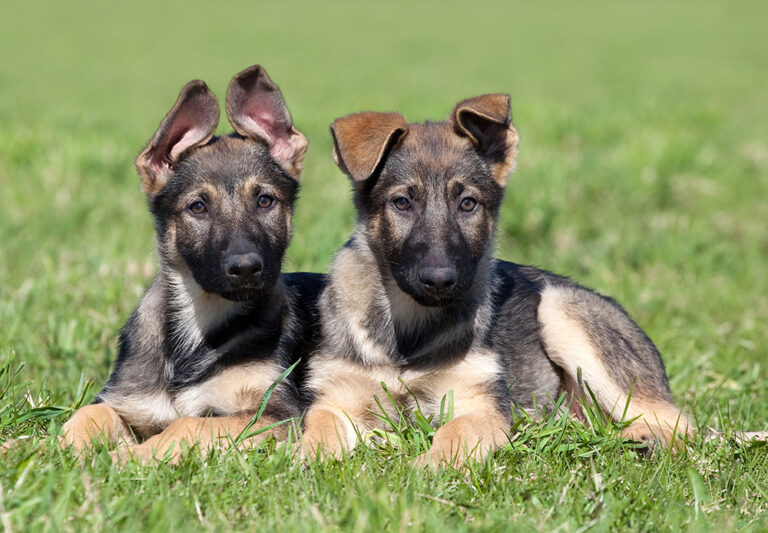
Where to look for your German Shepherd puppy
After doing your research and determining you, your household and your lifestyle are a good match for a German Shepherd Dog, you have three options for finding a dog. You can adopt a puppy or adult dog from an animal shelter or rescue group or you can purchase one from a breeder. You can also adopt a retired show or working dog from a breeder. There are pros and cons to each of these scenarios.
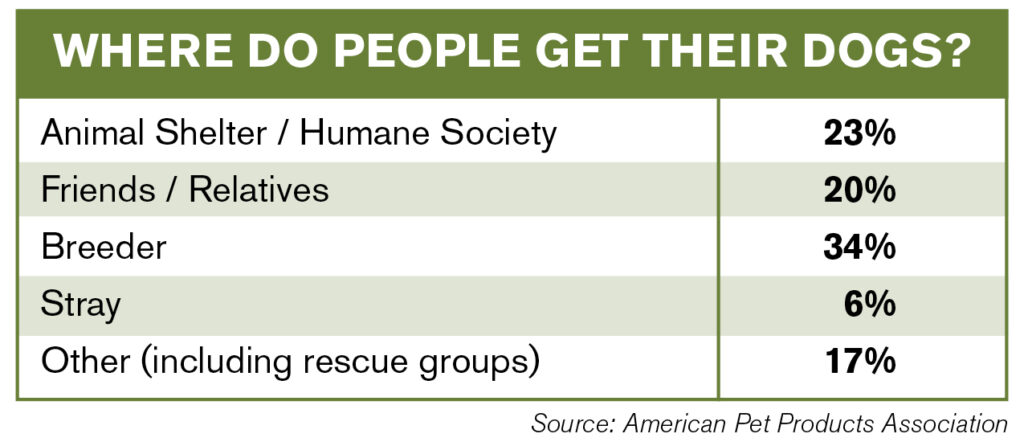
ADOPTION — TRUTHS AND MYTHS
Truths
- Adopting a older puppy or dog from a shelter or rescue can save you time and money on training as many are already social and house trained.
- You can avoid the baby puppy stage and not have to deal with house training, teething, etc.
- Adoption saves the lives of dogs that might not otherwise find loving homes.
- The cost of adopting is much less expensive than buying a puppy from a breeder.
- Often, there is absolutely nothing wrong with shelter/rescue dogs. People give up perfectly good German Shepherd puppies for many reasons unrelated to the dog.
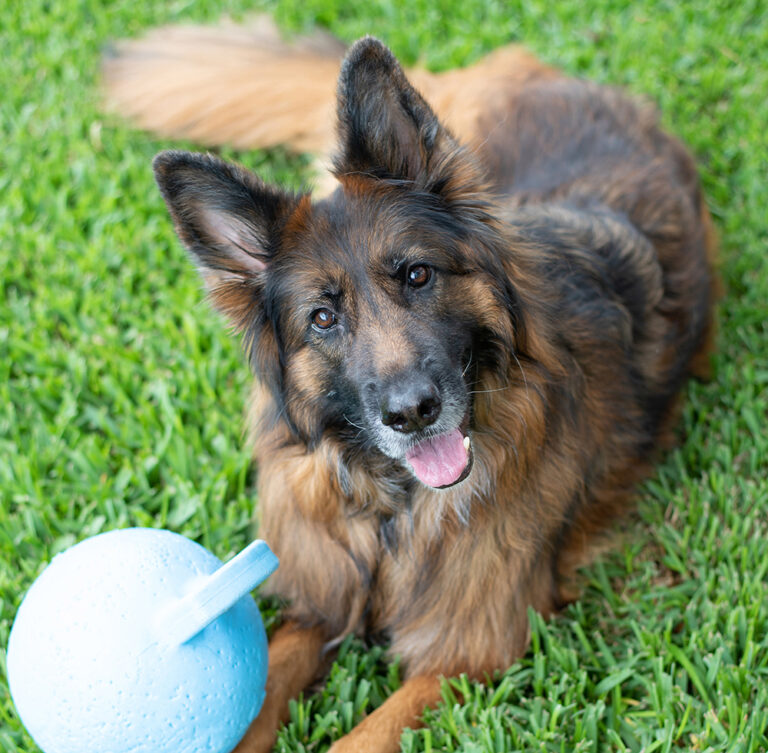
Myths
- Dogs end up in rescues/shelters because there is something wrong with them. A lot of families give up their dogs because they can’t afford them anymore, because job opportunities force them to move to a place where they can’t have dogs, they don’t want to deal with having an aging dog or they cannot care for the dog due to their own health issues—or they just don’t have the time to devote to a dog anymore.
- Shelter/rescue dogs have diseases or serious health issues. Dogs in shelters and rescues are vetted for health and temperament and are checked by veterinarians prior to adoption. They are also neutered and are current on required vaccinations. If health issues are identified, full disclosure is provided so perspective owners know what to expect.
- Shelter dogs are difficult to train. Most dogs are receptive to training at any age, size or breed. There is no greater incident of behavioral issues in rescue/shelter dogs than there is in purebred dogs purchased from breeders.
- You will never know the dog’s history. Many rescue groups and shelters do have some history on their dogs, especially if they are owner surrenders. Not knowing the history behind a dog is not always a bad thing because dogs don’t dwell on the past—they live in the present.
- Most shelter dogs have behavioral issues. Many people that should never have gotten a dog, get one. They might have been an unguided gift, or they could have been acquired on a whim. And some people are just irresponsible or inapt at pet ownership. Many great dogs just need an opportunity to thrive in a loving, compassionate relationship.
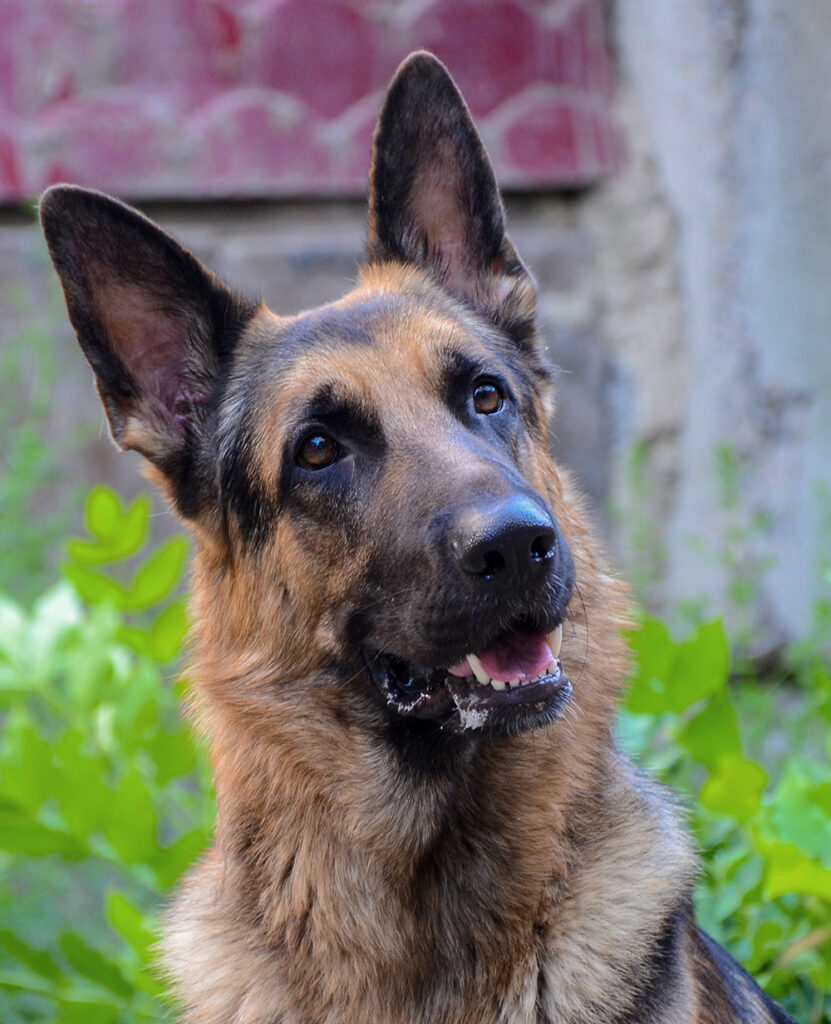
- Shelter dogs are old. Dogs of all ages enter into rescues and shelters. Adopting an adult dog means there will be no surprises on how big it gets and its temperature is also easier to assess. Older dogs also learn quickly and many come with a knowledge of basic obedience and are already house trained. Senior dogs can be ideal for quiet, low-energy households or for situations where someone wants a loving companion but can’t make a 10- to 15-year commitment.
- Adopted dogs cannot bond with new owners. Most dogs live in the moment which means the thing most precious thing to them is the person standing in front of them. Some dogs were never afforded an opportunity to bond in their previous experiences—so when it is offered, they embrace it unconditionally.
- Qualifications for adoption from a shelter are too stringent. Most shelters have very few restrictions regarding adoption, whereas rescue groups often require interviews, site visits, etc. Rescue groups have fosters caring for their dogs in their homes, so there are less time and space constraints so more involved vetting can occur. Shelters on the other hand are frequently over run with available pets and housing is limited. Their goal is to reduce the amount of time a dog has to spend in the shelter before a loving home is located.
- Shelter dogs are untrained. Many young and older dogs found in shelters and rescues are fully house trained and know basic obedience commands. And many have simply never had the opportunity to live indoors and do very well when given the opportunity. It is often easier and faster to house train an adult dog than a baby puppy.
SELECTING A BREEDER
One of the most important pieces of advice we can offer is to let you know that not all German Shepherd breeders, or any breeder of dogs, are created equal. As with an profession, there are dog breeders who are exceptional at what they do and there are those who have no business even owning dogs let alone breeding them. Should you decide to get a German Shepherd puppy from a breeder, listed below are practices that differentiate ethical German Shepherd breeders from backyard breeders.
Practices of Ethical German Shepherd Breeders
- The health and well being all adult dogs and puppies are a priority and focus is on quality over quantity. Many of these breeders only produce 1-2 litters per year or less.
- Breeding pairs are fully health tested to help reduce the risks of disease predisposed to the breed and they follow a strict breeding program to keep their lines healthy and genetically diverse.
- Proof of the sire and dam’s health—detailing hip, elbow, and other health testing is readily available—along with certified pedigrees confirming registration, age and parentage.
- Proof of working and show titles are readily available.
- All dogs adequately groomed, clean and free of parasites.
- Kennels or other housing facilities are licensed as required, clean and open for inspection and visitation by appointment.
- Questions are encouraged and answered freely and in detail.
- The sire and dam are made available to buyers when possible. If the sire is offsite, contact and other information are made available.
Practices of Backyard German Shepherd Breeders
- The health and well being their adult dogs and their puppies are a priority and their focus is on quality over quantity.
Selecting your German Shepherd puppy from a litter
You don’t want to go home with just any German Shepherd puppy, although they all are adorable. You want to select one that will be compatible with you and your family. Consider the following when picking a puppy from the litter:
- Choose a puppy that is sociable around you and other puppies.
- Pick a puppy that walks confidently with its head high and tail up and wagging.
- Choose a puppy that has clear eyes, ears, and teeth, walks evenly, and appears clean. Basically, choose a puppy that looks healthy.
- Look at the personalities of the puppies. If the pup doesn’t play nice and bounces off the walls at the breeders, it is likely that will be how he acts once you get him home.
- Choose a welcoming puppy that wants to greet you as opposed to one that retreats or appears shy.
- Ask to interact with each puppy one by one after seeing them with their littermates. That way you can get a better sense of how the puppy
responds to you without distractions.
Many potential owners make the mistake of choosing the largest, loudest, or most rambunctious puppy in the litter, but that doesn’t
guarantee that this will be the best dog for you. If possible, visit the litter at least three times before making a final decision, this will allow you to determine the personalities of each of those little fluff balls, and see which would best fit into your family.
How old should a German Shepherd puppy be when you take it home?
Any puppy should be at least 8 weeks old before being separated from their mother. Until then, the puppy still needs the mother’s milk and the company of his littermates to develop social skills.
By this timeline, their sensory organs will have also developed fully which will help you to spot any deformities or medical issues.
Be wary of any breeder that will allow you to take your puppy home before 8 weeks old.
Identifying Virtues and Faults in German Shepherd Puppies
Eight-week-old German Shepherd puppies exhibit many of the virtues and faults they will carry into adulthood. When evaluating quality puppies, you want to look for the same qualities you desire in adults. A healthy, conformationally sound puppy should appear balanced and well proportioned. It’s body should be slightly longer than it is tall; it’s head should be in proportion to its body; and its eyes should be bright and expressive.
Learning to accurately evaluate show/breeding potential in puppies takes years of practice—and even then we are sometimes surprised. However, by applying what we know about correct conformation in adult dogs, we can learn to see potential in puppies. Genetics and good
nutrition ultimately determine how our puppies look, but there are proven ways to help you make a better choice.
The first thing to remember is if a puppy’s legs are too leggy at 8 weeks, it’s legs will probably be too long as an adult. If it lacks a lower jaw, it will not develop a better one later in life. If it has a bent tail, experience tells us the bend will not smooth out. Do not fool yourself into thinking the faults you see today will diminish or go away tomorrow because chances are they will not. Sometimes, puppies can outgrow some of their minor imperfections, but generally, what you see is what you will get. Learn to identify the virtues and faults in 8-week-old puppies.
What if my puppy is going to be a pet? Do I need to be concerned with conformation faults?
The answer is yes. Even though your puppy might be destined to live its life as the king or queen of your loving pet home, some conformation faults can lead to a lesser quality of life for your puppy. If your puppy’s ears don’t come up, there is absolutely nothing to worry about as hanging ears do not have any health implications for the puppy. But what if your puppy is down in it’s pasterns, it’s extremely cow hocked in the rear, it does not move affortlessly when it walks, or has only one testicle? All of these faults can lead to health issues for your puppy and large medical bills for you. Poorly formed joints, misaligned teeth or jaws, bodies that are severely underweight or overweight are all indications that there could be serious issues down the road for your puppy. This is why it is important to know what to look for and what to run from when selecting German Shepherd puppies. If a puppy is discounted, it is usually discounted for a reason.
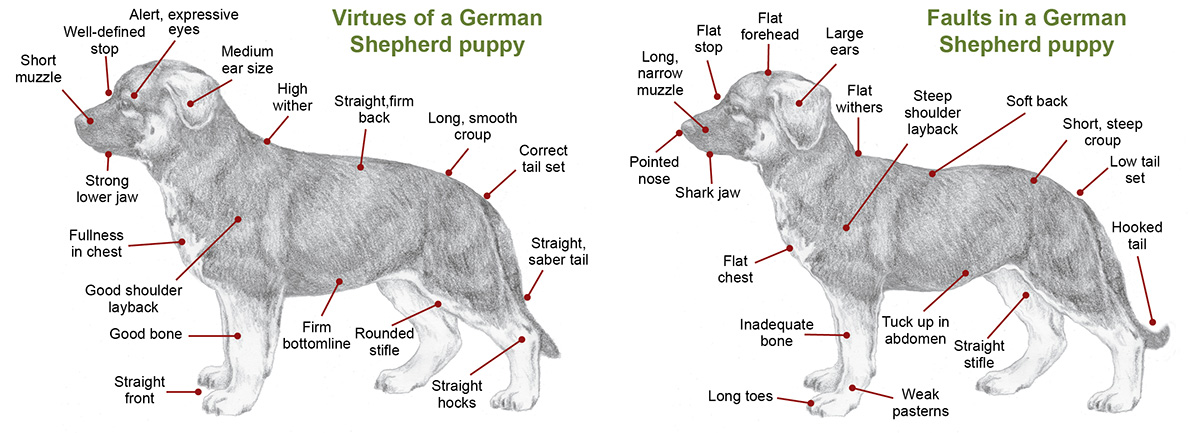
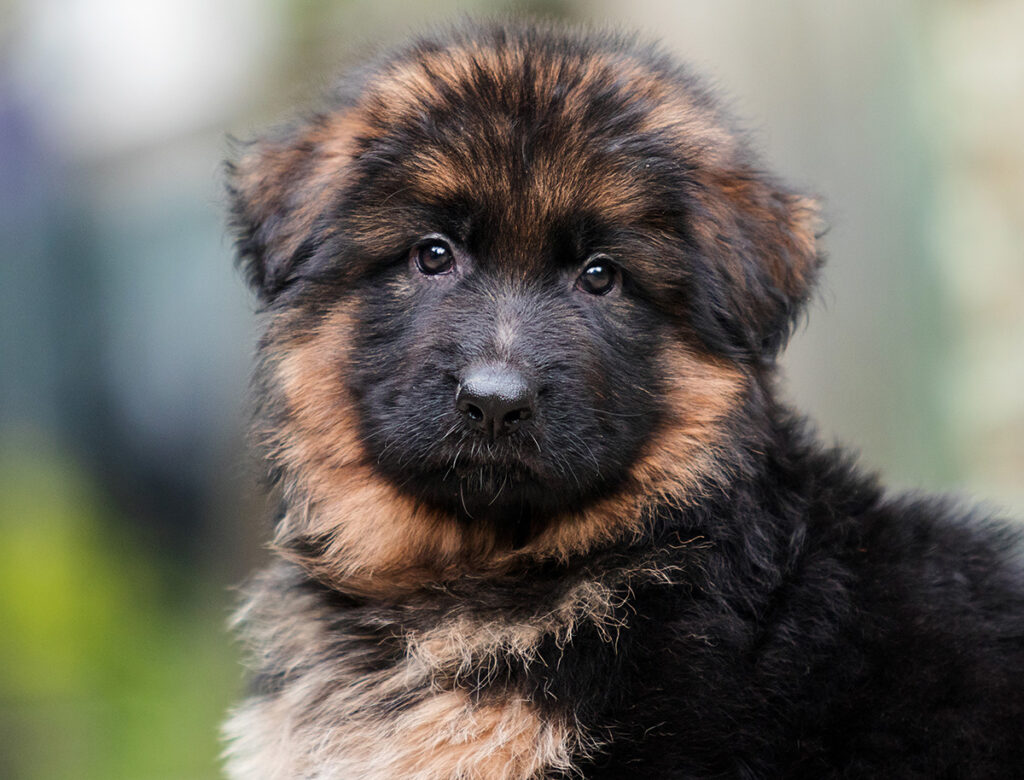
Shape of the Head
The muzzle of German Shepherd puppies should be short and have a slope similar to that of the head. The stop should be well defined. Experience has shown that most puppies loose at least some of the angle to their stop as they mature. So the steeper the stop, the better. If the puppy lacks stop at 8 weeks, chances are it will have no stop at all as an adult. Unlike adults, puppies have muzzles that are slightly shorter than their skulls. The muzzle should lengthen to equal the length of the skull as they mature.
Ears
The distance between the ears of German Shepherd puppies should be one- or two-fingers width apart with closer being better. When folded forward, the tip should not pass the upper eye rim. Check also for the width and thickness of the ears. Puppies with very wide, heavy ears are more likely to have soft or handing ears as adults.
Eyes
The darker the eye color, the better. They should not be set too far apart and should be positioned where the muzzle meets the stop. They should be bright, clear of any discharge and expressive.
Teeth and Mouth
A scissor bite is what you look for in German Shepherd puppies. Just like adults, a scissor bite is one in which the top teeth rest just slightly over the bottom teeth. The lower jaw should never fall short or protrude beyond the upper jaw. The gums should be pink and when gentle pressure is applied, they should turn white before quickly going back to pink. If the gums are white, ask the breeder when the last time the puppy was treated for parasites. The lower jaw should be visible when the mouth is closed. If not, the puppy has a shark jaw which impairs bite and detracts from the overall appearance of the head.
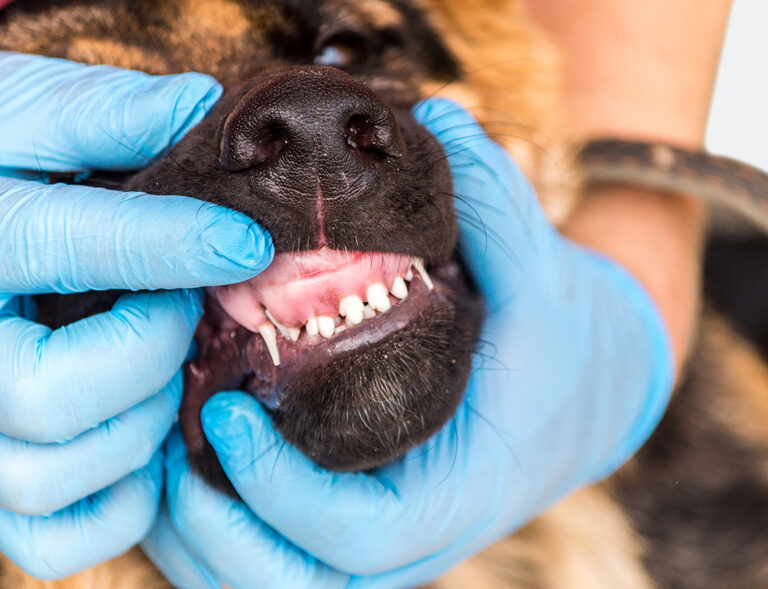

Shoulder, Chest and Front
Shoulder. A quality German Shepherd puppy should have correct shoulder layback. The breastbone should be prominent and extend past the shoulder bones.The distance from the withers to the shoulder joint, and from the shoulder joint down to the elbow, should be the same. When puppies have steep shoulders, it is usually a result of a short upper arm.
Depth of Chest. The bottom of the chest (rib cage) should be at or below the elbow, with below being more desired. Additionally, the distance between the front legs at the chest should be 4 fingers or more on an 8-week-old puppy.
Front Legs. The front legs should fall directly under the shoulders in a straight line without the paws turning too far inward or out. If the paws point outward, this usually means the puppy lacks depth of chest causing its elbows to pinch inward. The patterns should also be angled at approx. 22˚. An angle greater than this means the puppy is loosely ligamented and will have added stress on these crucial joints.
Body
German Shepherd puppies should have a body ratio of 10:9 with 10 being the length and 9 being height. Length of body should not be a result of a long back. The back of a good Shiloh puppy should be short, straight, and strong. Length of body should result from good depth of both the front and rear quarters of the puppy.
Topline. A good topline consists of a smooth transition from the neck to the withers and a gentle, straight slope from the top of the withers to the lower back. The best way to evaluate topline, especially on plush coated puppies, is to wet the puppy’s coat before during evaluation.
Tail and tail set. The tail of a German Shepherd puppy should extend past the hock and should hang straight without any bends, twists or rings. When the puppy is happy, the tail can move upward, but the end should not go above the croup. The tail set should start approximately 1” above the Ischial tuberosity (shelf) of the pelvis.
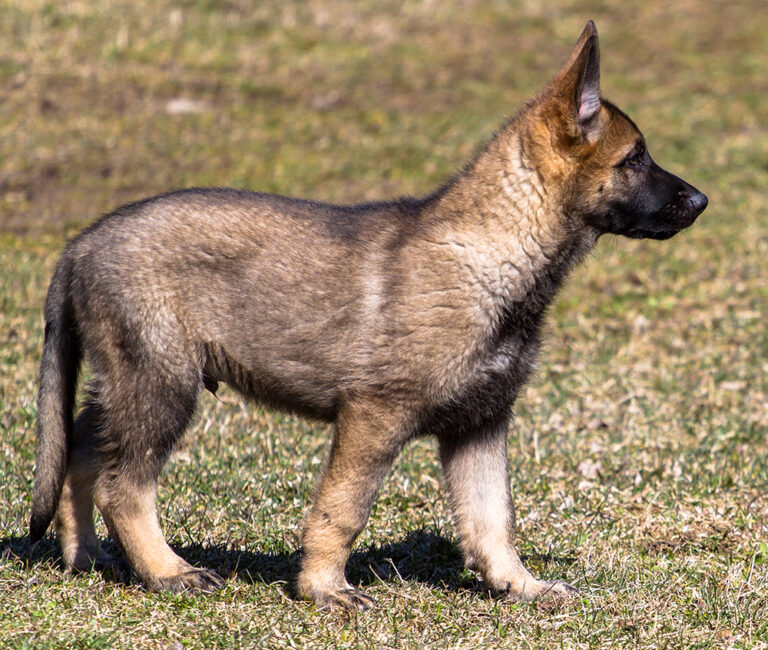
Feet and Legs
Hocks. When standing, the hocks on a German Shepherd puppy should be straight and not lean inward or outward. Most 8-week-old puppies are examined on tables during litter evaluations. Most however do not like tables or being restrained and this can influence the natural positioning of their hindquarters. A more appropriate method of evaluating hock structure is to view the puppy in a natural stance on the ground and during movement and without restraint.
Feet. Toes should be short, compact and close together. Toes that are long and flat (hare feet) are very serious faults. Check nail shape. With hair feet, the nails tend to grow straight out and look overly long.
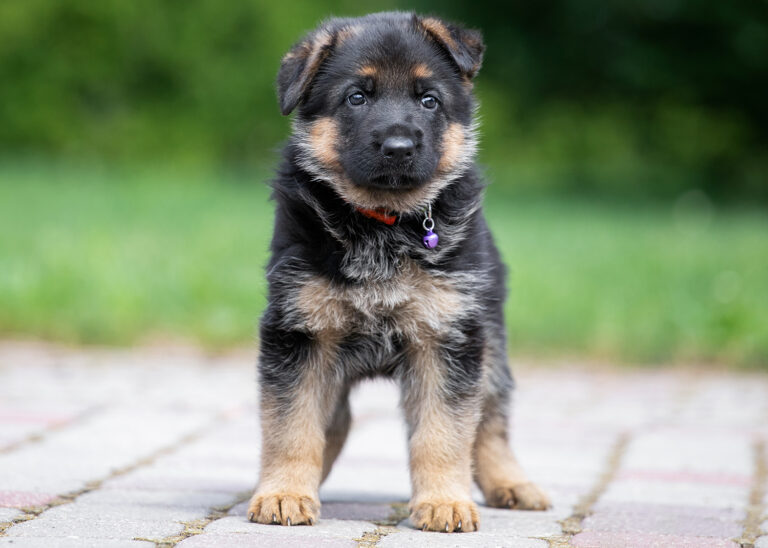
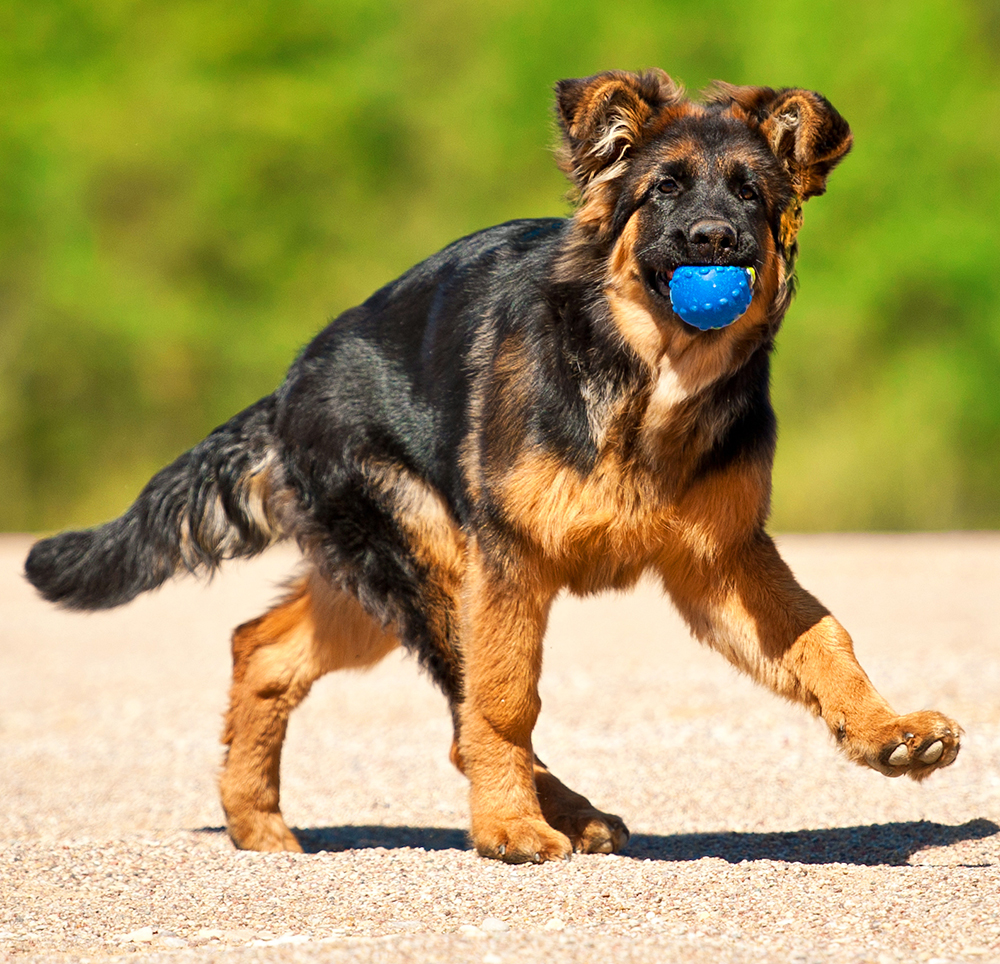
Gaiting (Trotting)
When observing German Shepherd puppies in motion, you want to look for single tracking. As the puppy comes toward you, it’s front legs should fall in a straight line from the shoulders and the front feet should not turn into the body or swing out or away from the body. The hind feet should be only slightly visible behind the front feet. If you can see both back feet with the puppy coming toward you, it is not single tracking, but moving crabwise or double tracking. This is a considered a faulty gait. The puppy pictured left is crabbing. Its hind legs are moving in a track different than its front legs because its rear reach is overpowering its front reach.
Reach. Front leg extension should be far reaching. Great reach is accomplished when an invisible line, drawn straight down from the tip of the nose, aligns with the front toes. Reach should be low to the ground on both the front and rear legs. Rear leg extension should be approximately equal to front leg extension.
Transmission. The rear legs should extend fully so that the pads can be seen when viewing the puppy while it’s moving away. Evaluate puppies on a smooth, firm surface that allows you to see clearly the positioning of the feet and the extent of reach.
Color and Pigment
Look for rich, consistent color in the coat of a German Shepherd puppy. Its leathers (muzzle, lips, eye rims) and toes should be predominantly black. Muzzles frequently fade or develop salt and pepper markings with maturity, so if a puppy has a faded muzzle at 8 weeks, chances are it will worsen with age. White markings on the chest are acceptable as long as it blends in with the surrounding hair as it matures. White toes or sugar feet, are acceptable as well as long as they also blend in with the surrounding hair. Most sugar feet disappear as puppies grow. However, large areas of white—on especially the front feet—are more difficult to blend and sometimes remain into adulthood. The most desired pigment is no white markings because they tend to increase in intensity and frequency with each generation. Pink noses on white puppies is a serious fault and if the lack of pigment remains through adulthood, it is considered a disqualifying fault. Pink noses are sensitive to sunlight and have greater incidences of dermatologic problems—aside from being extremely difficult to breed out of a line once they appear.

